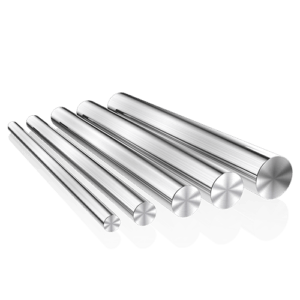Introduction

In today’s industrial landscape, the 316L stainless steel round bar stands out as a critical material known for its exceptional properties and diverse applications. This blog delves deep into the myriad benefits and practical uses of 316L stainless steel round bars, offering a comprehensive exploration of why it is favored across various industries.
Corrosion Resistance
316L stainless steel is renowned for its outstanding corrosion resistance, making it indispensable in harsh environments such as marine and chemical processing industries. The alloy’s composition, with a significant amount of chromium, molybdenum, and nickel, ensures robust protection against corrosion, including pitting and crevice corrosion. Moreover, its low carbon content enhances resistance to sensitization during welding, reducing the risk of corrosion in critical applications where structural integrity is paramount.
Chemical Resistance
One of the most significant advantages of 316L stainless steel is its high resistance to a wide range of chemicals, acids, and alkalis. This property makes it ideal for applications involving exposure to corrosive substances, ensuring longevity and reliability in environments where other materials would degrade or fail.
Strength and Durability
The 316L stainless steel round bar is valued for its impressive strength and durability. With a higher tensile strength compared to many other stainless steel alloys, it offers excellent structural integrity and reliability under varying loads. This characteristic makes it suitable for critical applications in construction, machinery, and heavy industries where reliability and longevity are essential.
High Temperature Performance
Another significant advantage of 316L stainless steel is its ability to maintain excellent mechanical properties at elevated temperatures. It can withstand temperatures up to approximately 900°C (1650°F) without significant loss of strength or corrosion resistance. This property makes it invaluable in industries such as aerospace, automotive, and manufacturing, where components must perform reliably under extreme thermal conditions.
Oxidation Resistance
At high temperatures, 316L stainless steel round bar exhibits superior oxidation resistance due to its chromium and molybdenum content. This property ensures stability and performance in demanding thermal environments, where oxidation can compromise material integrity and performance.
Formability and Machinability
316L stainless steel offers good formability and machinability, allowing it to be easily welded, formed into complex shapes, and machined to precise tolerances. This versatility makes it a preferred choice in industries where custom fabrication and machining are essential, such as architectural designs, structural components, and industrial equipment.
Biocompatibility
The medical and pharmaceutical industries benefit significantly from the biocompatibility of 316L stainless steel. This material is widely used in surgical instruments, medical implants, and pharmaceutical processing equipment due to its inert nature and compatibility with human tissues. Its resistance to corrosion in bodily fluids and its ease of sterilization make it indispensable in critical healthcare applications.
Sustainability and Recyclability
Stainless steel, including 316L grade, is highly sustainable and recyclable. Its long lifespan, durability, and recyclability contribute to environmental conservation efforts and reduce the overall carbon footprint of industrial processes. This aspect aligns with global sustainability goals and makes stainless steel a preferred choice for environmentally conscious industries.
Aesthetic Appeal
Beyond its functional advantages, 316L stainless steel round bars are valued for their aesthetic appeal. They can be polished to a high luster, finished in various textures, or even colored through processes like electroplating or powder coating. This makes them suitable for architectural applications, interior design elements, and decorative components where both functionality and visual appeal are important.
Cost-effectiveness
Despite its premium qualities, 316L stainless steel round bars offer long-term cost-effectiveness. The initial investment in high-quality material pays off through reduced maintenance costs, longer service life, and minimized downtime in industrial operations. This aspect makes it a preferred choice for industries looking to optimize operational efficiency and reduce lifecycle costs.
Applications of 316L Stainless Steel Round Bar

| Application | Description |
|---|---|
| Marine | 316L stainless steel is extensively used in marine environments for components like boat fittings, shafts, propellers, and underwater structures. |
| Chemical Processing | It is favored in chemical plants for its corrosion resistance, used in tanks, valves, pipelines, and other equipment handling corrosive chemicals. |
| Aerospace | Used in aircraft components due to its strength, corrosion resistance, and high-temperature performance, including fasteners, structural parts, and engine components. |
| Medical Equipment | Widely used in surgical instruments, medical implants, and pharmaceutical processing equipment due to its biocompatibility and corrosion resistance. |
Conclusion
316L stainless steel round bars are essential materials in modern industrial applications, offering exceptional corrosion resistance, strength, durability, and aesthetic appeal. Their versatility and reliability make them indispensable across industries ranging from marine and chemical processing to aerospace and medical equipment manufacturing. For businesses and engineers seeking high-performance materials that deliver long-term value, 316L stainless steel remains a top choice.
FAQ
Q: What is the difference between 316 and 316L stainless steel?
A: The main difference lies in their carbon content; 316L stainless steel has a lower carbon content, enhancing its corrosion resistance and weldability compared to 316 stainless steel.
Q: Can 316L stainless steel round bars be used in high-temperature applications?
A: Yes, 316L stainless steel maintains good mechanical properties at elevated temperatures, making it suitable for applications up to around 900°C.
Q: Is 316L stainless steel recyclable?
A: Yes, stainless steel, including 316L grade, is highly recyclable, contributing to sustainability efforts in various industries.
